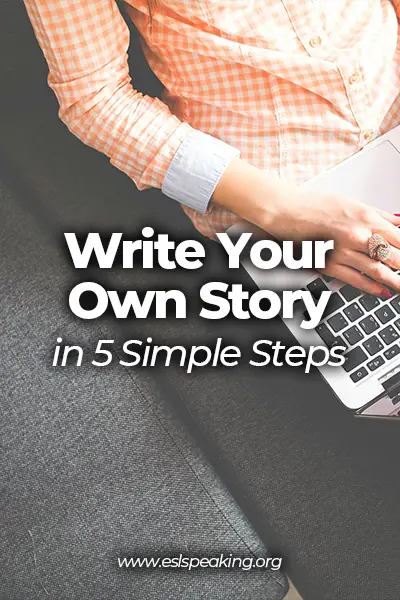Writing is a great way to express yourself or what’s in your mind. It is a fun and creative activity with many advantages. You don’t need to be a professional writer to write your own story. Whether you’re an English learner, an amateur novelist, or simply someone who wants to share your thoughts and imagination, writing your own story will be a deeply rewarding and amazing activity.

You’re probably here because you have no idea where to begin. That’s totally fine, and it is very normal to feel that kind of frustration. Getting started is probably the most commonly experienced challenge even among professional writers. We’re here to help you eliminate the stage of struggle and jump right into the writing phase. Now, check out our guide on how to write your own story in five simple steps.
How to Write Your Own Story
These are the 5 simple steps on how to write your own story in English. We’ll go over each step in more detail in the following sections.
- Research
- Brainstorm
- Outline
- Draft
- Edit

Step 1: Research
Now, you don’t have to go on Google Scholar and look for the most detailed information that ever exists. That’s probably the opposite of what you want to do. When I say research, I mean to find what you like. Here are some questions to help your research:
- What do I like?
- What inspires me?
- What is a topic that really interests me?
- What am I attracted to?
- Out of all the other things, why did this catch my eye?
- What if…?
You can ask these questions to yourself while walking around your town, watching a movie, reading a book, or even shopping. It can literally be anything you do through out the day. If you come up with an answer, take notes, so you don’t forget those golden ideas!
Step 2: Brainstorm
If you find an idea that you would like to write about from your research notes, start brainstorming. Jot down whatever comes to mind. They don’t have to make sense. Put a timer on for like 10 minutes and just try to write down everything you can think of. Don’t think about spelling mistakes, reasoning, or quality. There is no need to write sentences; stick to simple bulleted points. Only focus on moving all the thoughts in your mind onto a piece of paper or a digital notepad.
Once you’re done, use the brainstormed ideas to select the voice, tone, characters, settings, plot points, and particular scenes.
Step 3: Outline
If you have done some sort of academic writing in the past, think of this as something similar to creating an outline for an essay. You need to create a framework and a timeline for events. The outline will act as a road map for your writing journey. What will happen in the beginning? What will happen in the climax? How will the story end? These are some example questions to start outlining.
Step 4: Draft
Start writing the first draft. Don’t feel the pressure to write a masterpiece on your first try. I can tell you for sure. That is just simply impossible. Even the greatest writers need someone to read over their work. Why? Because they know their first draft is going to have A LOT of errors. Your goal should be to get the first draft done. You can always go back and make changes. But you can’t make changes to a story that doesn’t exist. So, start typing!
Step 5: Edit
This is probably a step a lot of people hate to do. It’s not easy to read over your own work and find the mistakes. Yet, it is the most essential step that you must take in order to improve the quality of your story. If you read over your work too many times, it can be hard to detect plot holes or awkward paragraphs. When that happens, ask your friends or family members to read over your work. First-time readers are able to catch a lot of editing points that writers overlook. After gathering the feedback, make the changes and polish your story.
For basic grammar errors, I recommend using Grammarly. It is a free typing assistant software that is pretty good at catching spelling mistakes and punctuation errors. However, you can’t solely trust Grammarly, as it’s not 100% correct all the time.

FAQs About How to Write Your Own Story
Here are some of the most frequently asked questions about how to write your own story.
What is the best definition of a story?
A story is a fictional narrative that presents a sequence of events involving characters, settings, and conflicts, often with the goal of entertaining, informing, or conveying a message or theme.
What are the different types of stories?
The different types of stories include short stories, novels, fairy tales, mysteries, science fiction/fantasy, romances, historical fiction, and adventures.
How do I start writing my own story?
Try to come up with an idea or concept that excites you. Brainstorm the personalities, motivations, and goals of your characters. Choose the setting, theme, and major conflicts. Outline the main plot points and important events. Start writing and get ready to revise it multiple times.
What are the 5 parts of a story?
The 5 parts of a story are introduction(exposition), rising action, climax, falling action, and resolution.
What is the plot of a story?
The plot of a story refers to the sequence of events that make up the narrative. It typically includes elements such as exposition, rising action, climax, falling action, and resolution.
What is the basic plot structure when you write a story?
The following are the basic plot structures that people follow when writing their own stories.
- Introduction: Introduce characters, setting, and initial conflict.
- Rising Action: Develop the conflict, introduce obstacles, and build tension.
- Climax: The highest point of tension or drama, where the main conflict is confronted.
- Falling Action: Address the aftermath of the climax, resolve subplots, and tie up loose ends.
- Resolution: Provide closure, reveal the final outcome of the conflict, and offer insight or reflection.
More Writing Resources
If you are looking for additional English writing resources, check out the following.
- Choose your Own Adventure ESL Writing Activity
- ESL Writing Practice: Focus on Fluency | Write English Fluently
- ESL Teaching Philosophy: How to Write One
- IELTS Writing Tips | Tips & Tricks for IELTS Writing
Write Your Own Story: Join the Conversation
Do you have an exciting idea that you really would like to write about? What is it? Let us know in the comments! We’d love to hear about it.





Leave a Reply